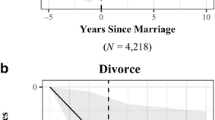Abstract
This paper develops a model of remarriage for women with particular emphasis on the role of investments in marriage-specific human capital. A distinction is made between marriage-specific skills that are transferable across marriages and those that are specific to a particular spouse. It is hypothesized that transferable marriage-specific skills constitute an asset and a major component of gains from marriage for previously married women. A high level of such skills is expected to be associated with fast remarriage. The presence of children is expected to delay remarriage, because it indicates lower levels of past and future investments that would be relevant to a new partnership. These hypotheses are examined using Cox-regression techniques with data on white and black women from the 1982 National Survey of Family Growth. The empirical results are consistent with the hypotheses. A systematic pattern of race differentials is uncovered, which can be interpreted within the context of the model.
Similar content being viewed by others
References
Bahr SJ (1979) The effects of welfare on marital stability and remarriage. J Marriage Family 41:553–560
Becker GS (1974) A theory of marriage. In: Schultz TW (ed) Economics of the family. The University of Chicago Press, Chicago London, pp 299–344
Becker GS (1981) A treatise on the family. Harvard University Press, Cambridge London
Becker GS, Landes EM, Michael RT (1977) An economic analysis of marital instability. J Polit Econ 85 (6):1141–1187
Bell D (1974) Why participation rates of black and white wives differ. J Hum Resourc 9:465–479
Breslow N (1974) Covariance analysis of censored survival data. Biometrica 30:89–99
Carliner G (1981) Female labor force participation rates for nine ethnic groups. J Hum Resourc 16 (2):286–293
Castro-Martin T, Bumpass LL (1989) Recent trends in marital disruption. Demography 26 (1):37–52
Cherlin AJ (1981) Marriage, divorce, remarriage. Harvard University Press, Cambridge London
Chiswick CU (1982) The value of a housewife's time. J Hum Resourc 17 (3):413–425
Cox DR (1972) Regression models and life tables. J R Statist Soc B 34:187–202
Duncan GJ, Hoffman SD (1985) A reconsideration of the economic consequences of marital dissolution. Demography 22 (4):485–498
Espenshade TJ (1985) Marriage trends in America: estimates, implications and underlying causes. Popul Dev Rev 11 (2):193–245
Glick PC, Ling-Lin S (1986) Recent changes in divorce and remarriage. J Marriage Family 48:737–747
Gronau R (1980) Home production — A forgotten industry. Rev Econ Statist 62:408–416
Hoffman SD, Duncan GJ (1986) A choice-based analysis of remarriage and welfare decisions of divorced women. Presented at the meetings of the Population Association of America, San Francisco
Hoffman SD, Duncan GJ (1988) Multinomial and conditional logit discrete choice models in demography. Demography 25 (2):415–427
Hutchens RM (1979) Welfare, remarriage and marital search. Am Econ Rev 69 (3):369–379
Kalbflcisch JD, Prentice RL (1980) The statistical analysis of failure time data. John Wiley and Sons, New York
Keeley MC (1977) The economics of family formation. Econ Inquiry 15:238–248
Koo HP, Griffith JD, Suchindran CM (1983) The effects of children on divorce and remarriage: A multivariate analysis of life table probabilities. Presented at the Annual Meeting of the Population Association of America, Pittsburgh
Lam D (1988) Marriage markets and assortative mating with household public goods. J Hum Resourc 23 (4):462–487
Lehrer EL (1988) Determinants of marital instability: a Cox-regression model. Appl Econ 20:195–210
Lehrer EL (1990) The stability of first and higher order marriages: a comparative analysis. Paper presented at the Annual Meeting of the Population Association of America, May 2–5, Toronto
Lehrer EL, Nerlove M (1984) A life cycle analysis of family income distribution. Econ Inquiry 22 (3):360–374
Lillard LA, Waite LJ (1988) Children and marital disruption. Unpublished manuscript, RAND
Lippman SA, McCall JJ (1976) The economics of job search: a survey. Econ Inquiry 14:155–189
Menken J, Trussell J, Babakol O (1981) Proportional hazards life table models: an illustrative analysis of socio-demographic influences on marriage dissolution in the United States. Demography 18:181–200
Michael RT (1973) Education in nonmarket production. J Polit Econ 83:306–327
Michael RT (1979) Determinants of divorce. In: Levy-Garboua L (ed) Sociological economics. Sage, Beverly Hills London, pp 223–254
Mincer J (1974) Schooling, experience and earnings. National Bureau of Economic Research, New York
Mortensen DT (1970) Job search, the duration of unemployment, and the Phillips curve. Am Econ Rev 60:847–862
Norton AJ, Moorman JE (1986) Marriage and divorce patterns of U.S. women in the 1980s. Presented at the Annual Meeting of the Population Association of America, San Franciso
Rosen S (1983) Specialization and human capital. J Labor Econ 1:43–49
Sawhill IV, Peabody GE, Jones CA, Caldwell SB (1975) Income transfers and family structure. The Urban Institute, Washington DC
Schultz TW (1975) The value of the ability to deal with disequilibria. J Econ Lit 13:827–846
Shaw LB (1985) Determinants of the increasing work attachment of married women. Work Occupat 12 (1):41–57
Spanier GB, Glick PC (1980) Paths to remarriage. J Divorce 3 (3):283–298
Teachman JD (1986) First and second marital dissolution: a decomposition exercise for whites and blacks. Sociol Qu 27 (4):571–590
U.S. Bureau of the Census (1983) 1980 Census of population, United States summary. US Government Printing Office, Washington DC
Author information
Authors and Affiliations
Additional information
We gratefully acknowledge helpful comments and suggestions by anonymous referees and by participants of the Economic Demography Workshop at NORC and the Human Resources Workshop at the University of Illinois at Chicago.
Rights and permissions
About this article
Cite this article
Chiswick, C.U., Lehrer, E.L. On marriage-specific human capital. J Popul Econ 3, 193–213 (1990). https://doi.org/10.1007/BF00163075
Received:
Accepted:
Issue Date:
DOI: https://doi.org/10.1007/BF00163075




